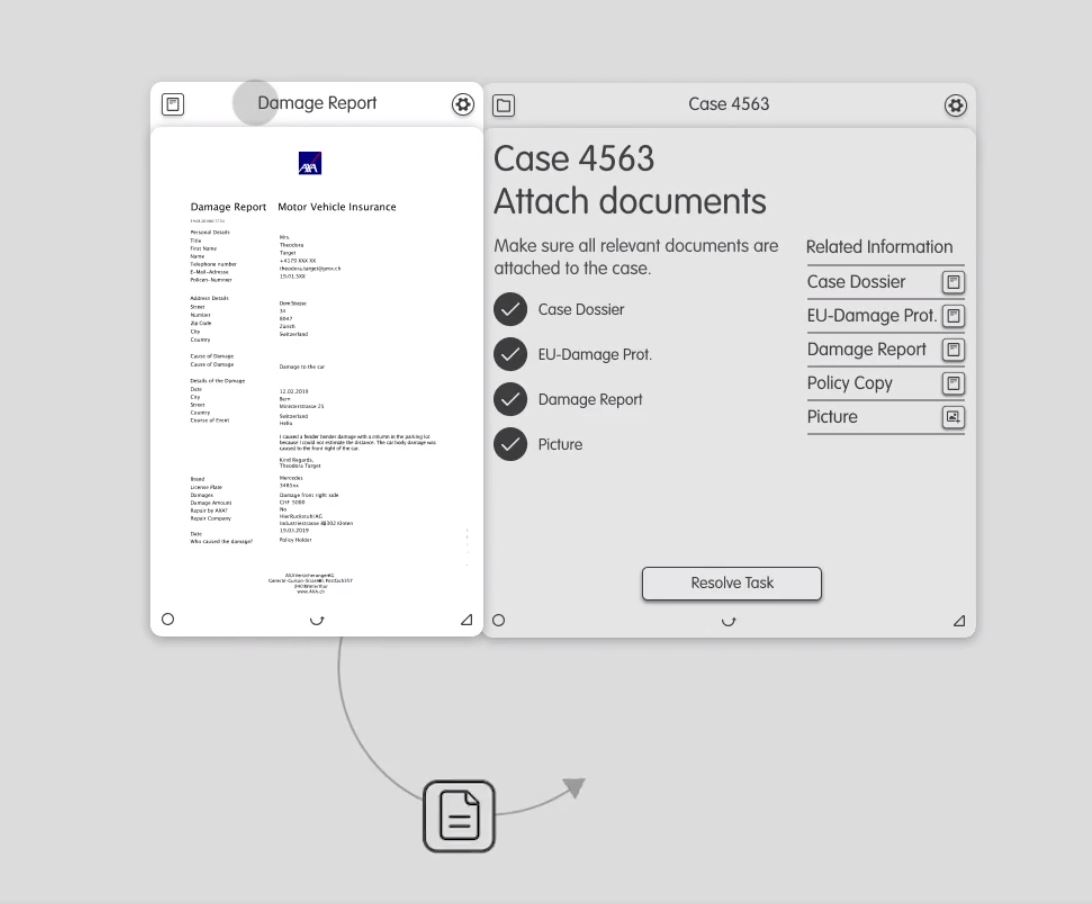Composite Orchestrated Experiences
Here at dizmo we often refer to the notion of composite business experiences: take your composite front-end platform called dizmo, surface subsets of data from system 1, system 2, etc, onto a decisioning and actioning surface, and you build your business outcome there in a noticeably short time frame.
In a recent sales meeting, a product owner sitting on the other side of a Zoom screen termed this as “Off-the-Shelf Innovation”.
Why “Composite”?
Dizmo is about simplification in digital transformation initiatives. Simplification happens if you can be taking packaged business capabilities and make them work together both holistically and quickly (see image below of – very interactively – transferring a report into an insurance claims system simply by pushing the digital objects together). It’s a collaborative technology that enables smooth and instantaneous information exchange between systems in just 3 lines of code.
With such simplicity, solution architects, product owners and even users can build composite business experience, relatively speaking, very quickly indeed.
Why “Orchestrated”?
Well, simply put, once you have the data, as a user you need to decision it. Dizmo is an orchestration surface that enables expedited analysis-to-action workflows. The user will be able to organize, analyse, customize and combine data on the fly – workflowing the data dynamically.
In the below example, which is the view of a claims analyst in a Property & Casualty insurer, the analyst has orchestrated an analysis-to-action workflow across 5 different systems in 8 clicks.
These dynamic, orchestrated workflows are what enabled the Swiss branch of a large insurance company to reduce average handle time for the management of a claim by 50% for a certain complexity class of claims types.
How did we get here?
It’s a testament to our early design principles, which today generate tangible benefits along many business types and domains, be it IoT, heath, insurance processes.
Dizmo was borne out of the desire to turn rapidly developing technologies, separate systems, collections of data, atomised app components and microservices into an intuitive, coherent interface to the human – one that allows the user to interact with the overall system in the most intuitive and agile manner.
Designed on the principles of simplicity, interoperability and intuitive user interaction, dizmo is consistently striving to solve the most painful points of data workflowing in ways that relieve users overwhelmed by an array of apps and an abundance of data.
We identified early on some key aspects that will impact the future of digital platforms and focused attention on making them strongholds for the entire product line of innovation propositions: integration, orchestration, superior usability, flexibly reframing work processes and a handful more.
Some examples of how dizmo design principles benefit the user:
-
Silo-breaking – Dizmo is a front-end for otherwise incompatible systems and silo’ed applications. Fragmented systems landscapes and interoperability still pose a real obstacle in many sectors such as insurance, healthcare, networked buildings, the smart city, the smart home, Industry 4.0 and more.
-
Dynamic Case Management, for example, the technique to get a “piece of work” done and which is used often in insurance and healthcare, is founded on managing the tasks along functional siloes. This is actually the example we are seeing in the image above.
-
Microservices front-end – Built as a modular, micro-frontend, dizmo is, in a sense, an “API surface”, enabling therefore the possibility of surfacing data from any IoT device in the smart home, your content, services from your service catalogue as well as 3rd party AI.
This is why we are enabler in the Smart Home for the evolution beyond consumer device solutions, as Gartner advocates, from the networked home that it is today to the learning home that it should be tomorrow.
-
Easy extensibility – Via modular integration of additional/new micro-services into a unifying workspace now a “Must Have”. “Ad Hoc API integration” is the ability to “loosely couple” in another module (API) or additional workflow, without having to launch, test and support a whole new system and create another silo.
One Global Head of Manufacturing called this ‘the ability to mix and match and change the system technology underneath but to show the same face to the customer. Ideal for Process Control and changing the process on the shop floor’.
-
Connecting data – Dizmo is designed to filter out the information white noise while filtering in only the relevant and needed data to get the task done. Simplification is achieved by being able to surface the subset of the content he/she needs from the shared data bulk and then make connections between them. We facilitate the connecting of data with patented technologies such as the “docking” technique: via simply joining two APIs together on the UI level.
This could literally be the Field Technician pushing together a visual representation of an ERP API with geolocation technologies to view his work order data locationally; or automating the data in a damage report plus all of the analysis metadata associated through to an electronic claims management.
We cannot claim to be eliminating the complexity of data and applications in its entirety for the user with these applied techniques. But they do achieve some of the journey towards that goal. Dizmo is democratising data: that is, reducing its complexity, removing some of the steps to get the job done, and speeding up decisioning capability.
In a study published by Accenture in the Harvard Business Review called Human + Machine: Reimagining Work in the Age of AI, they referred to The Missing Middle: ‘It turned out that 91 percent of the surveyed companies target process efficiency through task automation, while they do not address how to make the most of their human workforce.’ Let’s hope some of dizmo data empowerment techniques can be enabling the human workforce to make “Better Decisions, Faster”.

